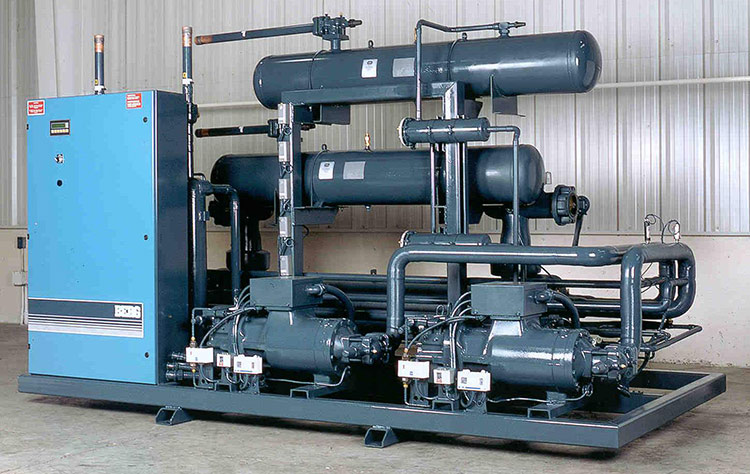Introduction
Refrigerant Phase-Out play a crucial role in the cooling process of chillers, but many traditional refrigerants contribute significantly to ozone depletion and global warming. Regulatory bodies worldwide, including the Montreal Protocol, the Kigali Amendment, and regional laws like the EU F-Gas Regulation and EPA SNAP (USA), have mandated the phase-out of high-GWP (Global Warming Potential) refrigerants. This shift is driving chiller manufacturers to adopt low-GWP and environmentally friendly alternatives while ensuring compliance with new regulations. As a result, chiller design is undergoing a technological transformation to accommodate alternative refrigerants such as R-1234ze, R-513A, R-32, and natural refrigerants like ammonia (R-717), CO₂ (R-744), and hydrocarbons (R-290). These refrigerants have different thermodynamic properties, safety considerations, and environmental impacts, necessitating major modifications in compressors, heat exchangers, safety mechanisms, and system efficiency. The transition also presents engineering challenges, such as higher operating pressures, flammability risks, material compatibility, and energy efficiency optimization. Chiller manufacturers must balance performance, cost, safety, and regulatory compliance while ensuring long-term adaptability to future refrigerant transitions.
Transition to Next-Generation Refrigerant Phase-Out
- Regulations like the Kigali Amendment and F-Gas Regulations are phasing out HFCs (R-134a, R-410A) and HCFCs (R-22).
- Alternative refrigerants include R-1234ze, R-513A, R-32, and natural refrigerants (CO₂, ammonia, hydrocarbons).
- New refrigerants require optimized thermodynamic cycles to maintain cooling performance.
Compressor Redesign for Efficiency & Compatibility
- Refrigerants with different pressures and temperature characteristics require redesigned compressors.
- Introduction of variable-speed drive (VSD) compressors to optimize performance with new refrigerants.
- Some refrigerants need oil-free magnetic bearing compressors due to lubrication compatibility issues.
Heat Exchanger Modifications for New Refrigerants
- Some new refrigerants have lower heat transfer coefficients, requiring larger or more efficient heat exchangers.
- Microchannel heat exchangers are becoming popular to improve heat transfer and reduce refrigerant charge.
- Stronger materials (stainless steel, aluminum alloys) are required for refrigerants operating at higher pressures.
Higher System Pressures & Component Durability
- Many alternative refrigerants (e.g., R-32, CO₂) operate at higher pressures, requiring robust piping, valves, and seals.
- New expansion valve designs are needed to accommodate refrigerants with different boiling points and flow characteristics.
- Leak-proofing measures are crucial, as high-pressure refrigerants increase the risk of leaks.
Safety & Flammability Challenges
- Several low-GWP refrigerants (e.g., R-32, R-1234ze) have mild flammability (A2L classification), requiring:
- Enhanced ventilation systems in mechanical rooms.
- Automatic leak detection sensors for early hazard prevention.
- Flame-arresting designs to reduce ignition risk in sensitive environments.
Refrigerant Charge Reduction for Sustainability
- Chiller designs are now focused on reducing refrigerant charge to comply with environmental laws.
- Low-charge ammonia chillers are gaining traction in industrial applications.
- Secondary loop systems are being used to minimize direct refrigerant use.
Energy Efficiency Enhancements
- Refrigerant changes require chillers to be more energy-efficient to offset performance differences.
- Integration of advanced heat recovery systems to reuse waste heat.
- AI-driven adaptive control systems for real-time efficiency optimization.
Digitalization & Smart Control Integration
- IoT-based monitoring systems help track refrigerant performance and detect leaks.
- Smart chillers with cloud-based analytics enable predictive maintenance for different refrigerants.
- Automated charge management systems optimize refrigerant use and efficiency.
Retrofitting Existing Chillers for Compliance
- Many companies are upgrading old chillers instead of replacing them by:
- Replacing expansion valves and seals to support new refrigerants.
- Modifying compressors to handle different pressure and temperature ranges.
- Upgrading control panels for compatibility with new refrigerants.
Lifecycle Cost & Supply Chain Considerations
- Some next-gen refrigerants are expensive and less available, impacting chiller lifecycle costs.
- Manufacturers are developing multi-refrigerant chillers that can adapt to future changes.
- Sustainable manufacturing practices are being implemented to reduce carbon footprint.
Compliance with Global Energy & Refrigerant Regulations
- New chiller designs must meet:
- ASHRAE 90.1 efficiency standards.
- EPA SNAP refrigerant restrictions.
- Eurovent and F-Gas regulation guidelines.
- LEED and green building certifications.
Modular Chiller Designs for Future Adaptability
- Flexible modular chillers allow refrigerant upgrades with minimal redesign.
- Hybrid chillers using both traditional and new refrigerants are being explored.
- Interchangeable compressor and heat exchanger designs enable refrigerant adaptability.
Conclusion
Refrigerant Phase-Out of high-GWP refrigerants is not just an environmental necessity but also a catalyst for innovation in chiller technology. Manufacturers are responding with advanced heat exchanger designs, energy-efficient compressor systems, smart control technologies, and low-charge refrigerant solutions. While the transition comes with technical and economic challenges, it also opens the door for sustainable, high-performance cooling solutions that align with global climate goals. Moving forward, multi-refrigerant-compatible designs, AI-driven efficiency enhancements, and hybrid refrigeration cycles will shape the next generation of chillers. Companies investing in future-proof chiller designs will benefit from regulatory compliance, long-term cost savings, and enhanced operational efficiency. The future of chillers lies in eco-friendly, high-efficiency, and adaptable cooling systems, ensuring a smoother transition toward a greener, low-GWP refrigerant landscape.

